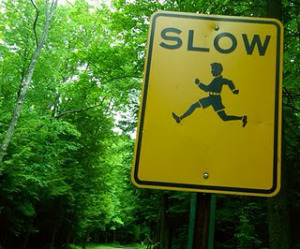I am not ready to give up.
After the "accident" it has been very hard to get back into running shape. I have never been a great runner, but I understand and appreciate the benefits of running. I referenced the "accident," the "accident" was actually no accident but the event of waking up one day and realizing that I was no longer in shape. The figure in the mirror was unfamiliar and the output of effort was harder than I remembered. So this brings us to today.
TODAY I will be better than yesterday.
TODAY I will run.
Slowly and shortly at first, but the distance and duration will get longer. Follow along. My goal is to fully document the path in hopes that one person will follow along. The personal achievement of getting into running shape and completing a 10k or half would be great but if I could motivate/inspire one person to make the decision to be more active that would be incredible. I also need help being held accountable and I promise to do the same for anyone who will join me on this journey. As frequently as possible, I will update my activity and what I am doing. I am excited to get started.
The article below is from RunnersWorld regarding slow running. I think this is a good start.
The article below is from RunnersWorld regarding slow running. I think this is a good start.
No Such Thing As Too Slow!
Going very easy keeps you fit and injury-free.
Running and/or run-walking at a comfortable pace strengthens your muscles, your lungs, and your heart, no matter what the clock says.
In fact, if you’re new to running or coming back after a long layoff, it’s best to forget about time entirely and focus on starting and finishing your run feeling good, no matter how ‘slow’ you go.
WHY TAKE IT EASY?
Doing your regular, weekday runs at a slow pace reduces the risk of injury dramatically while still contributing to your fitness.
A weekly long, slow run will improve your endurance, enhance your fat-burning ability, improve blood flow to your muscles, and build mental toughness. Failing to do the majority of your runs at a comfortable pace will lead to burnout – and possibly worse.
Comfortable runs deliver all of the joy of running, and none of the pain.
JUST HOW SLOW?
To make sure you’re running slowly enough, be aware of your breathing. If you’re huffing and puffing, you need to slow down or take more frequent walk breaks.
If you’ve done an easy run too fast, it’s likely you’ll notice it the next day – your legs won’t have their usual energy, and you may notice aches and pains.
If you have a tendency to run too fast on an easy day, try running with someone slower than you are. Avoid fast friends – save them for a speedier day.
HOW OFTEN?
Most runners can do all their runs at a comfortable pace with no downside. Runners with time goals, however, ought to add one day of speedwork each week to improve their performance.
One day of training at race pace can be added with little risk of injury, but the rest of your week’s runs should be comfortably paced.
Q+A: If I’m supposed to be running easy, how do I deal with hills, which are hard?
Shorten your stride down to ‘baby steps’, run on your toes, and make sure your arms are swinging to help propel you. Don’t try to maintain the same pace you held on the flats. If you start to breathe more heavily, add more walk breaks on uphill portions.
FACT OR FICTION?
I will never get any fitter if I run slowly all the time.
Fiction
Long, slow runs build your endurance while strengthening your musculo-skeletal and cardio respiratory systems. Short, slow runs help maintain that fitness. Consistent running, no matter how easy, will make you fitter; while going too fast, too often, can lead to injury.

Comments